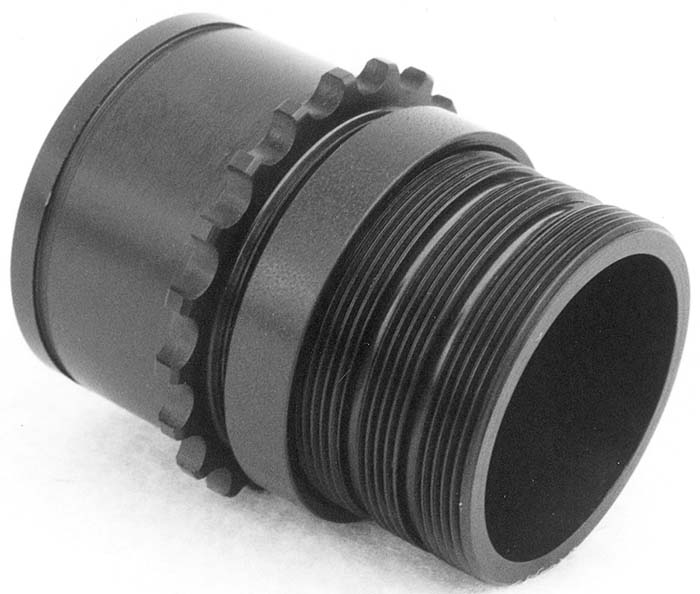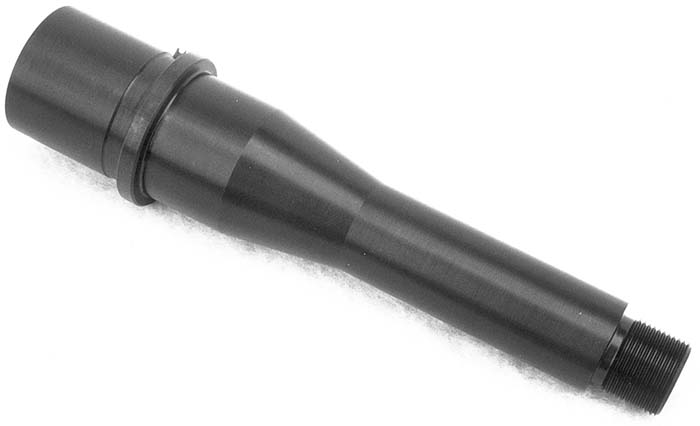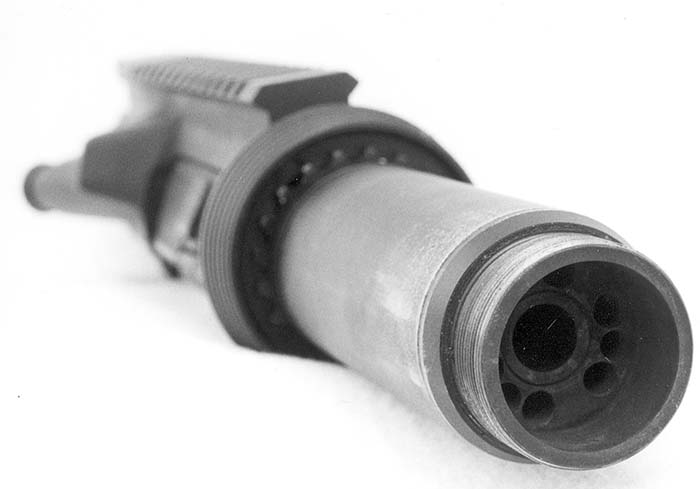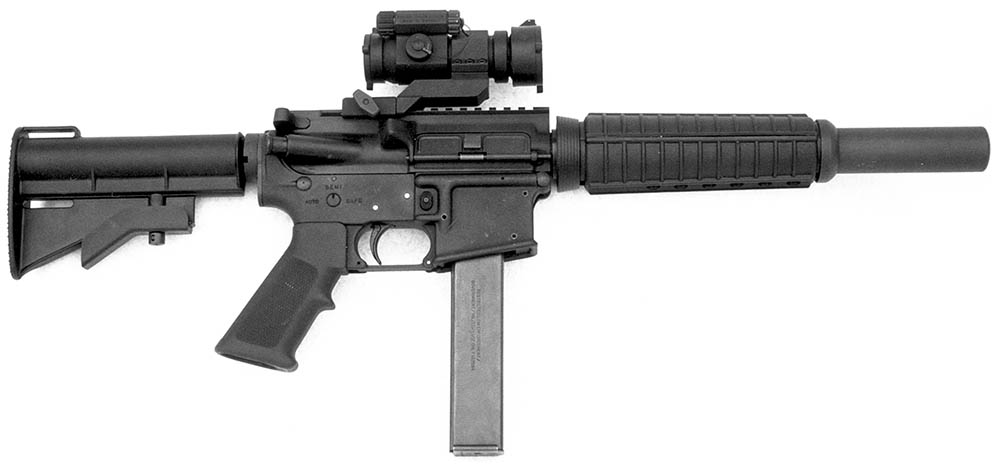The Talon SD assembly as received from Gemtech.
By William R. “Bob” Bishop
The Colt Model 635 9mm submachine gun, with its 10.5” barrel, has been a mainstay of many law enforcement and security organizations since its introduction in 1985. Although it has labored in the shadow of the HK MP5-series during this entire period, the Colt has increasingly earned a solid reputation due to its reliability, simplicity, availability of parts and reasonable price. Also, its commonality of training and maintenance with the full size M16 further reduces resource demands on overburdened armorer’s. In short, it is a well designed, US-manufactured submachine gun which provides a good alternative to the German MP5.
However, the one serious operational drawback the Colt Model 635 has demonstrated when compared to the MP5 is its lack of a first class sound suppressor. The Colt factory has never released a “SD/schalldampfer” sound suppressed version of the Model 635 which could compete against the MP5SD, and for this has lost out on a profitable market niche. Unfortunately for Colt, the demand for suppressed SMG’s has increased during the past several years for reasons to be discussed.
If only there was a suppressed Colt Model 635 SMG which would equal – or exceed – the MP5SD is performance specification while still retaining those factory features which give it such good reliability.
Well…there is now!
Gemtech has finally come to Colt’s rescue and just released their Talon SD upper receiver assembly which is a drop-in to the Colt Model 635 9mm lower receiver. Or, for that matter, onto any lower receiver which meets Colt’s 9mm specifications. Plainly stated, this is the suppressed Model 635 which the Colt factory should have done.

The Talon SD assembly as received from Gemtech.
Bottom line: Gemtech’s Talon SD is the quietest suppressed 9mm SMG I have ever fired or heard…and it appears “factory” in every possible respect. I should know, having spent three full days in taking one apart, gauging and inspecting it, then measuring its sound levels with various types of 9mm ammunition. Want to learn more?
Then read on, as SAR thoroughly examines what is surely to become the standard of comparison for suppressed 9mm SMG’s – the Gemtech Talon SD.
Background
The Gemtech Talon SD suppressed upper receiver assembly is a direct response to the lack of a similar offering from the Colt factory. It is designed to appeal to three markets: police/law enforcement, civilian and military. The police segment is the most important as their direct action teams have an increased need for correctly suppressed weapons. Several reasons for police use of a suppressed SMG include reducing chances of an explosion in certain adverse environments (meth labs, etc.), ability to hear the tactical commands of the team leader, and, identify other team members by their reduced sound signature. Also, a suppressed SMG will eliminate the “bloom out” of some night vision devices when making nocturnal entries. Finally, a very important administrative reason for suppressing the Colt Model 635 SMG is its commonality of parts/training with the M16 rifle.
The civilian market should also create a healthy demand for the Talon SD, particularly as machineguns are getting incredibly expensive. Current NFA AR15/M16 owners are looking for ways to upgrade their collection without having to mortgage the house. A suppressed upper receiver assembly is a most cost effective way to increase the “fun factor” without tearing up the budget. Or the wife tearing up the husband…I know!
Finally, while the military market is a factor, it is not a major contributor. US forces (USAF Combat Controllers, Army Personal Security Detachments, etc.) have only a limited number of Colt SMG’s at their disposal and those who do will generally not be using suppressed versions. For those who need suppressed SMG’s, the HK MP5SD has already made significant inroads.
Thus, even with the wide open police and civilian markets, Colt has never produced a suppressed 9mm SMG other than the small production run of DEA guns from 1989…which Reed Knight actually built under contract. Some civilian C2’s have produced their own suppressed versions of the Colt Model 635, notably Joe Gaddini’s and John Norrell’s superb examples, but, overall the selection has been rather thin.
Recognizing that excellent markets existed for a suppressed Colt 9mm SMG, and already famous for their advanced line of 9mm suppressors, Gemtech decided in 1998 to begin the design and development of what is now the Talon SD. Their work has now paid off and the Talon SD has just been released onto the market. We will examine it in detail.
Construction
The Talon SD is composed of four distinct subassemblies: the receiver, barrel nut, barrel and suppressor. The barrel nut, barrel and suppressor are custom made by Gemtech to their own design, while the receiver is an ultra-high quality product from American Spirit Arms (ASA) of Prescott, AZ.
Receiver
This ASA receiver is the highest quality one available today and, according to Greg Latka of Gemtech, is repeatedly “dead on” with regard to all military specifications – both dimensional, hardness and finish. Gemtech very carefully inspected/gauged a number of upper receivers before finally settling on this one as the basis to build the Talon SD. Since ASA is a family business, they personally direct the quality control of their product and are extremely proud of it. Gemtech went for absolute quality and gladly pays $50-60 more per upper to get it.
The ASA upper receiver arrives at Gemtech with the ejection port door and circular forward assist assemblies already installed, along with separate aluminum delta ring, snap ring and weld spring parts. ASA also provides the thermoplastic carbine handguards which come with stamped steel liners. The receiver’s front takedown pin hole is of the .249” small size to mount on all milspec lower receivers. Also, the necessary relief cut has been milled by the factory in front of the rear takedown lug to permit clearance of the full auto sear. The finish is a milspec black anodized coating which is flawless in shade and evenness of application.
The receiver is forged from 7075-aluminum into the very popular “flat top” A2-style format which supports all Picatinny rail accessories and optical sights. Currently, it has the case ejection buffer (.223 style) built into the receiver, but, future receivers will be purpose built to complete 9mm specs. Regardless, it looks and functions perfectly well as is.
Barrel Nut
The barrel nut is designed and built by Gemtech for the Talon SD and is considered the “heart” of the overall system. This is because it not only holds the barrel into the receiver, but seals off combustion blowback, provides primary mounting for the suppressor and indexes/retains the handguards.
This critical component starts life as a block of 1020-series medium carbon steel and is initially turned on a Hardinge Superslant CNC lathe to form its primary shape, cut the suppressor rear mounting threads and create the o-ring sealing groove. Radial porting is then done on a Cincinnati Milicron Sabre 500 machine to produce the pulling points needed by the installing barrel wrench. After three machining operations and a total of eight minutes machine time, the barrel nut is finished and in-the-white. At this point it is carefully gauged by Gemtech to ensure adherence to specific military dimensional standards and then black oxided for surface protection.
Early pre-production versions of the barrel nut had two o-ring sealing grooves to absolutely ensure no blowback would exit the rear of the suppressor and impact the operator. However, this proved overkill and also made mounting the suppressor more difficult. Consequently, production barrel nuts have one o-ring sealing groove.

The custom machined barrel nut. A standard colt barrel wrench easily installs it. The o-ring grooves are clearly shown here. Early production nuts, such as this one had two o-ring grooves which led to sealing overkill. Current production nuts have only one groove which easily meets the need.
Barrel
The barrel is also specifically designed and manufactured by Gemtech for the Talon SD. It starts life as a Douglas Premium 4100-series high carbon steel 9mm barrel blank. This blank has a 1/10 twist rate to stabilize the full range of 9mm cartridges and is optimized for those in the 147gr. weight (ie, subsonic) class. Gemtech had considered porting the barrel to keep the slug from exceeding 950fps, but, with the wide availability of quality subsonic ammunition it was decided the correct solution was to avoid porting and use a shorter barrel of greater torsional strength and accuracy. Consequently, its length of 5.0” yields more accuracy potential than a 9mm cartridge can effectively deliver. In other words, the barrel is better than the cartridge!

The 5” long Douglas Premium 9mm barrel removed from the upper receiver to better show it’s profile. The chamber end will fit in any milspec upper receiver and the threaded muzzle axially centers the front of the primary expansion chamber around the barrel.
The Douglas barrel blank is first cut to length and then turned between centers on a Hardinge Cobra 42 CNC lathe to less than .001” runout over the entire length. This equipment takes fifteen minutes machine time and six machining operations to complete its task, including threading the muzzle to support the forward suppressor mount. It is then precision crowned and has the chamber cut with a Brownell’s 9mm chambering reamer. The locating pin is drifted in, the entire barrel is carefully gauged, and it is then finished with a coating of black oxide.
Suppressor
The Talon SD suppressor is a completely new design – including the baffle stack – and is designed to run under the stamped steel liners of the plastic handguards. It is composed of two assemblies: the primary expansion chamber module and the baffle stack module. Overall length of the total suppressor unit is 10.5” and it extends a mere 4.0” past the forward handguard ring. This is definitely not a large unit which looks ungainly or out of place. In fact, it is only 1/2” longer than the flash suppressor of the Colt Model 635 and thus fits into the same size envelope. Weapons racks, drag cases, etc, which fit the Model 635 should fit the Talon SD.
The primary expansion chamber module is made of 1 3/8” diameter, 4100-series high carbon steel for operational ruggedness. Remember, the primary market is for police tactical entry teams! The back of the module is internally threaded to screw into the mating threads from barrel nut, while tightly sliding over the silicon o-ring which the nut contains. This effectively seals out any suppressor blowback. The front contains the muzzle flange which centers the module over the barrel muzzle and also controls the porting of the rapidly expanding combustion gasses.

Looking directly into the front of the primary expansion chamber module. The small section closest to the viewer contains the threads over which the suppressor module is mounted.
This flange is a critical component of the overall Talon SD system. It is made of 1020-series steel and is initially machined on a Warner & Swasey Titan 4-axis CNC lathe, finish machined on a Hardinge Superslant CNC lathe and then ported on a Sabre 500 4-axis CNC mill. The number, location and size of these ports are integral to the Talon SD’s incredible performance and remain proprietary knowledge to Gemtech. This is because the primary expansion module does not use wire mesh, brass grommets or any other artificial method of controlling/cooling the expanding gasses. The contained air volume, in conjunction with these precisely milled ports, are all that is needed by the primary expansion chamber module to do its job.
With the primary expansion module screwed in place, the suppressor is now perfectly dual-point aligned with the barrel – and also provides the mounting platform for the baffle stack module.
The baffle stack module is also made of 1 3/8” diameter, 4100-series high carbon steel and supports the handguards via the specially designed front ring. More importantly, it also contains the proprietary “K-shape” baffle stack which Gemtech designed over a two year period specifically for the Talon SD. These baffles are made of CNC-machined high tensile strength aluminum alloy with a specialized heat treatment. Further, they have a tab/groove method of interlocking and alignment to ensure they permanently remain in the correct physical relationship.
The baffle stack is mounted in the tube by a combination of threading, Loctite and a retaining ring. Interestingly, the blast baffle (next to the endcap) is a markedly different and specially developed to optimize turbulence just before the hot combustion gasses exit the endcap. Once the baffle stack is fully installed, the endcap is screwed in and Loctited in place. Overall, there has been an incredible amount of design work in only a few inches of baffle length.
Finally, both the primary expansion chamber and baffle stack modules are prepared for finishing by first being heavily sand blasted to create uniformity and optically flat matting. Then, they are black oxided to provide corrosion protection and further reduce any potential light reflections. Once this is done, the BATF-required manufacturer’s information is then precisely engraved with an Excello laser machine. This is done in multiple passes to ensure the markings are of sufficient depth to prevent their accidental removal in any subsequent refinishing operations or operational use.
The ASA receiver/handguards, the proprietary barrel and barrel nut, along with the two modules comprising the suppressor assembly are all then assembled together, carefully examined and then test fired. Upon passing this inspection, they are boxed up for their lucky future owner and…….a new Talon SD is born!
But, what does this beautifully machined suppressor sound like?
Sound Measurements
I have heard/fired a number of suppressors over the past few years and can firmly state that Gemtech’s Talon SD is the quietest 9mm unit I have yet observed. It is that simple. Even though all suppressors are based on various tradeoffs to achieve their decibel reduction (size/volume, number and type of baffles, mounting system, etc.) this Talon SD seems to have optimized each variable in order to achieve its outstanding performance.
Having said this, let’s see exactly what the performance specifications are to validate this claim!
Sound measurement testing on this particular day was conduct with the Larson Davis Labs Model 800-B meter hooked into the LDL Model 2530 1/4” pressure microphone. This expensive (over $5000) setup meets all the specified requirements of MIL-STD-1474C and is annually sent back to the Provo, UT, factory by Gemtech to have it recalibrated/certified. Also, the 20 microsecond rise time of this equipment meets both US military and NATO standards for sound measurement levels regarding gunfire. Furthermore, in order to best replicate the frequency sensitivity of the human ear, the “A” weighting scale was selected. Finally, temperature for testing was 70F with a 15% relative humidity rate….perfect for a long day at the range. In short, this setup is an extremely sensitive sound measurement device which can quantitatively detect/measure the very quickly rising sound of a shot.
As the Talon SD is specifically designed for subsonic ammo, four different types were used in the testing: 1) IMI 158gr.; 2) Black Hills 147gr.; 3) Sandia 147gr.; and, 4) Custom-K’s “Special K” 147gr. The first three types of ammo have been around for years (especially the IMI and Black Hills) while the fourth one is becoming very popular on the East Coast and is now being commercially sold at the Knob Creek MG shoot. Therefore, as these are pretty much the best subsonic cartridges which are commercially available, they were selected for the sound measurement test.
Because the Talon SD is integrally suppressed, and unsuppressed fire is not practical, a benchmark for comparison purposes needed to be established for each cartridge. To obtain this unsuppressed reference, each of the four cartridge types was first fired through an HK MP5A3 with 8.85” barrel. This yielded the base measurement off which the Talon SD’s performance could be evaluated. Not perfect, but it does allow an “apples to apples” comparison of the Talon SD and the four cartridges. Hint: there is a difference between the cartridges!
The table below shows exactly how the Talon SD performed in relation to each of the cartridges. Further, to ensure each test round was fired in a consistent manner, I shot them all myself over a grassy (non-reflective) field with the microphone 1.6m high and exactly 1m to the left of the muzzle.
While the table speaks for itself, the subject of “1st Round Pop” needs to be addressed. Many suppressor owners notice that the first round they fire tends to sound a bit louder than all subsequent shots. This is because the ambient oxygen which is trapped in the suppressor causes a slight increase in sound as the rapidly expanding combustion gasses hit it. Follow-on shots do not encounter this oxygen as the first shot has already exhausted it. Thus, not only is absolute decibel reduction a prime factor, but, that very first shot must be factored in, too.
Clearly, the Talon SD yields outstanding suppression. Currently, any 9mm suppressor which reliably achieves around 30db is one to be reckoned with. To honestly exceed 30db puts it in the very upper tier of performance. With the Special K ammunition giving an unprecedented 33.9db reduction, the Talon SD allows the Colt Model 635 to literally become the quietest 9mm SMG in current production today. Even with the IMI and Black Hills ammo, the Talon SD remains at the very impressive 30db level.
How did the Special K cartridge achieve well over 4db more suppression when compared to the industry standard IMI and Black Hills rounds? Simple, it was specially designed to do so from the very beginning.
Brad Galloway of Custom-K, the Special K designer, in conjunction with live fire testers from Isher Weapons/OPFOR Activities of Alabama, spent over a year in 1997-98 independently developing a subsonic 9mm cartridge which was optimized for the best QD external 9mm suppressor on the market – Gemtech’s Raptor. They also used only the highest quality components on the market: Federal nickel plated cases (best for long term storage), Remington 147gr. FMJ bullets (excellent feeding in SMG’s) and Vihta Vuori powder (ultra consistent and clean burning).
The end result is a bullet which travels through an MP5 barrel at 950fps and exhibits extremely low shot-to-shot variation. In short, unlike the other well known cartridges, the Special K cartridge was purpose-built for modern suppressed weapons and this is clearly evident. In fact, it is so impressive, I bought several thousand rounds for my own personal use and employ it in all my suppressed 9mm firearms.
All four cartridges fed out of the Colt 32-round magazines with absolutely no problems. Cycling within the Talon SD was also faultless with no misfires or malfunctions of any kind. It was noted, however, that the Special K ammo was definitely cleaner burning than the rest and its silver-color hulls were the easiest to find and pick up.
The final analysis of the suppression capabilities of the Talon SD indicates it is the industry leader in suppressed 9mm fire. When using purpose-built ammo such as Special K it achieves levels of suppression which heretofore were either marketing hype or incorrectly configured sound measurement equipment. The Talon SD is not hype and the sound measurements prove it.
Shooting Impressions
The Talon SD was designed to closely duplicate the size, weight , heft and feel of Colt’s Model 635 9mm SMG. Having owned a Model 635 since 1993, I can state that Gemtech fully met this key design criteria. When you pick up the Talon SD, it simply feels like a Model 635 with a “funny looking” fat barrel protruding out from the handguards. Ease of use, pointability, balance, etc. all feel precisely the same.
The total weight of the complete system (Talon SD and lower assembly) without ammo or magazine is 6.25lbs, and overall length with the stock collapsed is 26.25”. As the upper receiver is a flat top model and the front sight post is removed, an optical sight is mandatory. Any quality rapid-acquisition sight such as the Armson, Trijicon or Aimpoint will work perfectly well for the ranges at which a 9mm subgun is typically used. With its Picatinny rail system, a well made QD mount from ARMS or GGG will tightly hold the sight to the upper receiver without loss of zero or transmission of excessive firing vibration.
Firing the Talon SD is exactly the same as for any Model 635 or AR15 9mm carbine. Load the magazine with your chosen subsonic cartridge, chamber a round, take the selector off “safe” to a firing position and then squeeze the trigger. The dull bass thud! of the round going off, accompanied by the metallic clack! of the reciprocating bolt and swish! of the recoil spring is all you hear. A fraction of a second later the sound of the slug impacting the target echoes back along with the tinkling of the cartridge case bouncing off the pavement. It seems almost eerie to detect these various sounds as one has become accustomed to only hearing the high pitched crack of a unsuppressed weapon firing supersonic cartridges…all other sounds were completely masked.
One can really get addicted to firing the Talon SD with quality ammunition like the Special K factory load. Also, with the extreme sound reduction from this advanced system it is much easier to get younger people involved with our shooting sport. The overall robustness of the steel suppressor tube is a major plus for its primary intended market of law enforcement as accidentally bumping a door threshold or slamming it into an obstruction will damage it little, if at all.
Conclusion
The Gemtech Talon SD suppressed upper receiver assembly is a first class piece of ordnance. It is truly the suppressed “SD” version of the Colt Model 635 9mm SMG which the factory should have done…and did not. At a retail price of $949 for the complete suppressed upper receiver (minus the bolt, charging handle and front pin which come with the base weapon) this is a very fair price for an incredibly engineered system built for long term professional use. Gemtech also warranties the Talon SD to be free of defects in material and workmanship, while fully meeting the manufacturing specifications at the time of its manufacture. In other words, they will work their hardest to make the Talon SD owner a very happy customer.
Now, if my wife Linda can find the heart (and open the purse) for my own Gemtech Talon SD as our two young sons could use this excellent piece of hardware for reduced noise shooting. After all, “its for the children…”! Honest.
Gemtech
PO Box 3538
Boise, ID 83703
W: (208) 939-7222
Fax: (208) 939-7804
Webpage: www.gem-tech.com
Brad Galloway
Custom-K
1601-C Highland Ave
Montgomery, AL 36104
(334) 315-2937
| This article first appeared in Small Arms Review V4N5 (February 2001) |











